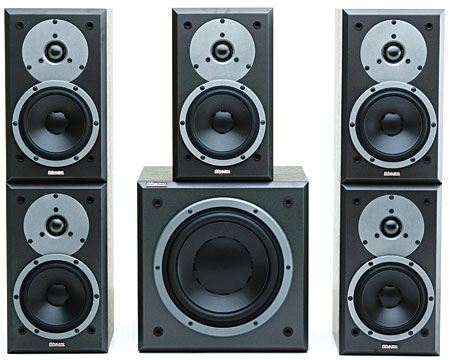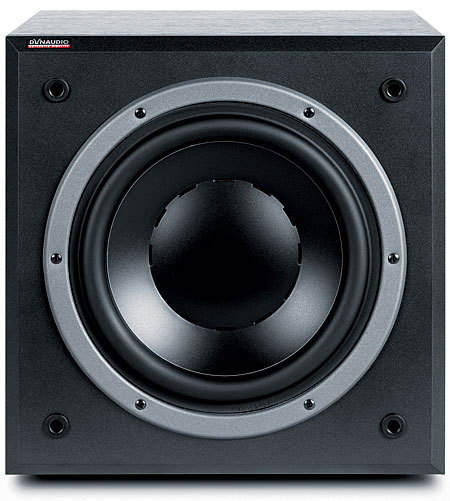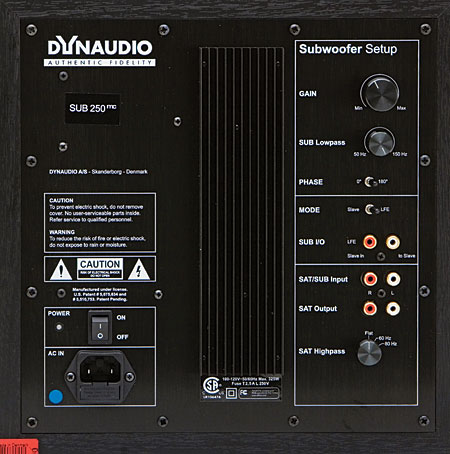Dynaudio DM 2/6 Speaker System
 Price: $2,650 At A Glance: Two-way monitor with silk-dome tweeter • 10-inch sub with both low- and high-pass filters • Refined performance with a touch of warmth
Price: $2,650 At A Glance: Two-way monitor with silk-dome tweeter • 10-inch sub with both low- and high-pass filters • Refined performance with a touch of warmth
Sweet Silk Dome
The Dynaudio DM 2/6 monitor comes in a vinyl-wrapped mediumdensity-fiberboard enclosure. This is so traditional, it’s almost retro. At the audiophile end of the speaker market, the vinyl-MDF box is outclassed by tantalizing veneers. At the pragmatic end—which is where a lot of the innovation comes these days—the vinyl-MDF box has given way to sound-bars and sat/sub sets with curvy molded-plastic or extruded-aluminum enclosures.

I think of vinyl and MDF as the speaker equivalent of a well-worn trench coat. It may not be dressy, but it’s rugged, functional, timeless, and a good thing to have when threats of economic storm darken the sky. Wood veneers are great for certain rooms and sensibilities. The pride of ownership they bring is worth something extra. But what if your budget moves you to prioritize, and you decide to prize a speaker’s contents and capabilities over its visual style? Then you might well prefer the staid-looking Dynaudio DM 2/6. When it comes to sound, the guy in this trench coat is wearing an opulent Italian suit underneath.
Born in Denmark
Correction, a Danish suit. Dynaudio is located in Denmark, where it was founded in 1977.
The company is well known in high-end circles for the quality of its speakers in general and its drivers in particular. This isn’t the first time I’ve ventured into the DM budget line; I also reviewed the 10-inch DM 2/10 in May 2008. Dynaudio’s other lines ascend through the value-rich Excite and Focus lines to the higher-end and more distinctive Contour, Confidence, and Evidence lines.
This review system includes five DM 2/6 monitors and a Sub 250 MC subwoofer. Although my review samples came in boxes of two, Dynaudio also sells the DM 2/6 in single units for a 5.1channel, 7.1-channel, or other odd-numbered configuration.
The DM 2/6 is less than a foot tall and unprepossessing. Its vinyl-wrapped MDF enclosure won’t win any beauty contests, but its looks are on the quiet side. What’s special about this Danish-made speaker is what’s inside.
This budget speaker has a voicing that fans of the company’s higher-priced lines will recognize. The DM 2/6’s tweeter utilizes a silk dome, and the 5.5-inch woofer cone is made of magnesium silicate polymer, a proprietary material that the manufacturer says combines low weight and controlled rigidity with low internal resonance. The cone and dust cap are formed together in a special manufacturing process, so there’s no need to glue the dust cap onto the driver. Dynaudio says the cone is geometrically optimized for smooth dispersion, and my ears agree. The pure aluminum that Dynaudio uses in the voice coil is also unusual. It allows it to be large and light at the same time.
The Sub 250 MC has a 10-inch woofer that sits close to the edges of its enclosure, a cube that measures 11.4 by 11.6 by 12.5 inches. There are no ports on the enclosure, making this a sealed sub—a relative rarity. The potential advantages of this design are better transient response and immunity from port turbulence. Dynaudio seems to opt for quality of bass output over quantity.

In the back-ported DM 2/6, Dynaudio seems to be hedging its bets on bass. The speakers come with foam inserts to plug the ports. If you want more bass output, you can leave the foam plugs out. That’s how the speakers are packaged—the foam inserts come in the little baggie with the instruction manual—so that’s how I used them. I didn’t find the speakers’ bass to be uneven, but my default speaker placement is about 2 feet out from the wall, which translates into minimal room reinforcement. Depending on your preferred speaker placement and your room’s acoustic characteristics, you may come to a different decision.
The sub comes with some interesting hookup options. If you just want to run an interconnect cable from your AVR’s sub-out jack, it’ll go to the sub’s LFE input. If you want to connect additional subs, there’s a slave output jack next to the LFE input. A toggle above them switches between plain-LFE or LFE-with-slave operation. Either way, you’ll bypass the sub’s crossover and use the one in your AVR.

- Log in or register to post comments




































































